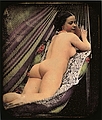Daguerreotypes - Technical details |
In the early years, most daguerreotypes were made on a mechanically produced silver coated copper plate, manufactured by rolling out a copper ingot with a layer of silver soldered to it. Later it became more normal to deposit silver by electrolysis on a carefully polished copper plate - this could be cut to the size required before plating. The following steps were then needed.
1. The silvered plate was cleaned with dilute nitric acid and carefully polished to remove all surface irregularities. The superior quality of US daguerreotypes was due to better polishing methods, including the use of machines.
2. The plate was then placed in a closed box with the silvered side a few inches above a layer of iodine crystals. A layer of muslin was sometimes placed between them to ensure even dispersion of the iodine vapour. For faster plates, a similar treatment with bromine or chlorine was given, usually after an initial exposure to iodine, and was followed by further exposure to iodine.
The process can be monitored visually in dim light. The iodine reacts with the silver metal to form silver iodide as a very fine layer. With continued exposure, this layer gets thicker, and as it does so, the colour of the plate changes, at first yellow, then orange and red and blue, before going back to yellow again and repeating the series of colour changes. As the layer thickens, the contrast of the plate reduces. The sensitivity to light is greatest at the yellow stage, decreasing to blue, and then increasing again as the plate returns to yellow. So the plate is usually used at the second or third time it becomes yellow.
3. The plate is placed in the camera and exposed for a time depending on the lens aperture, subject and lighting (and whether bromine or chlorine have been used to accelerate the process.) If a correct way round image is needed, a mirror is used in front of the lens, adding slightly to the exposure needed.
4. The plate was taken out of the camera in a dimly lit room and put into a developing box. Normally the plate was held at 45 degrees a few inches above a bath of mercury, heated by a small spirit lamp to around 60 C. A glass window in the side of the box enabled the development to be viewed - it was normally for around 20 minutes.
5. The plate was rinsed for a second in filtered rainwater, then immersed in a sodium thiosulphate solution until the yellow colour had completely disappeared (modern workers may like to fix for twice this clearing time.) It was then washed and dried. Gold toning was usually carried out by adding gold solution to the sodium thiosulphate fixer, or it could be done immediately after fixing, with just a brief rinse between the two baths.
6. If the daguerreotype was to be coloured, this was then done either by dusting on extremely finely powdered dry colours with a fine brush, or sometimes weaker colours might be produced by using solutions of the colour in alcohol. The colours mainly used were gold, carmine, chrome yellow and ultramarine, and they were mixed to produce other colours.
7. A metal or card overmat was then placed on the plate, with a sheet of fine glass on top. The overmat prevented contact between glass and plate. The edges were often sealed with tape before placing the image in a suitable case. Many cases were hinged to protect the image, and often had a dark velvet lining on the cover, which could help in viewing the image if held at the correct angle.
|




|

